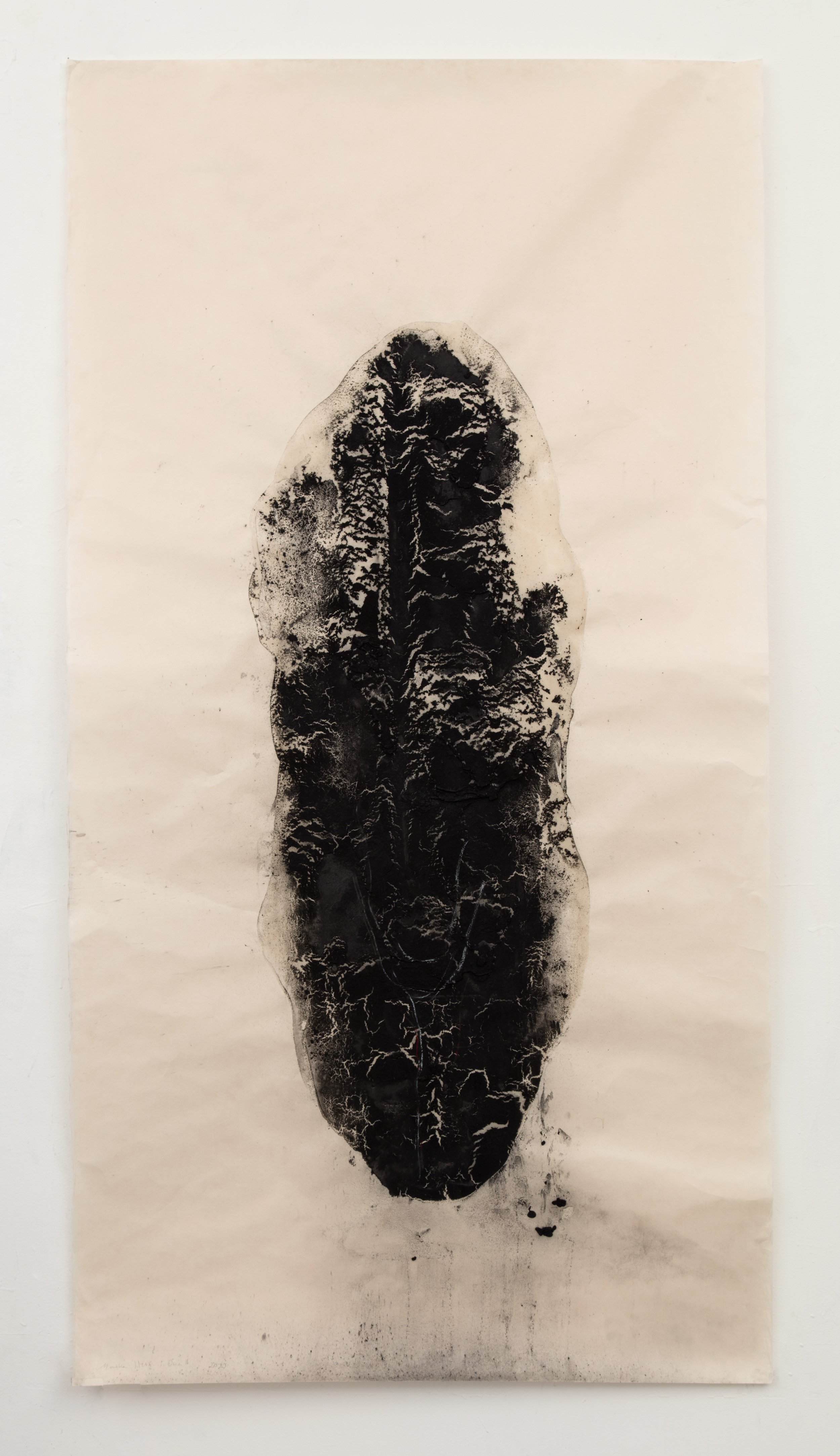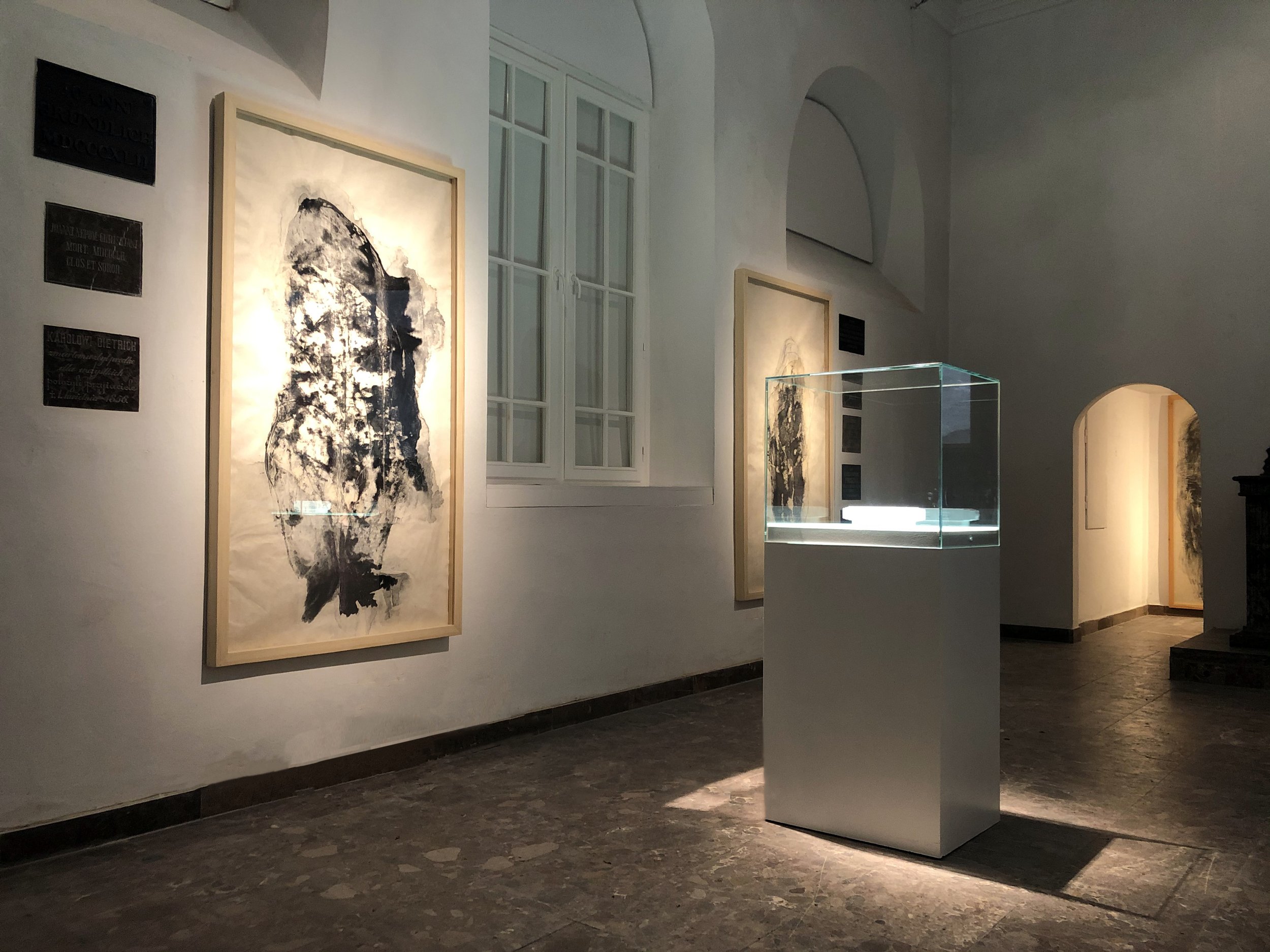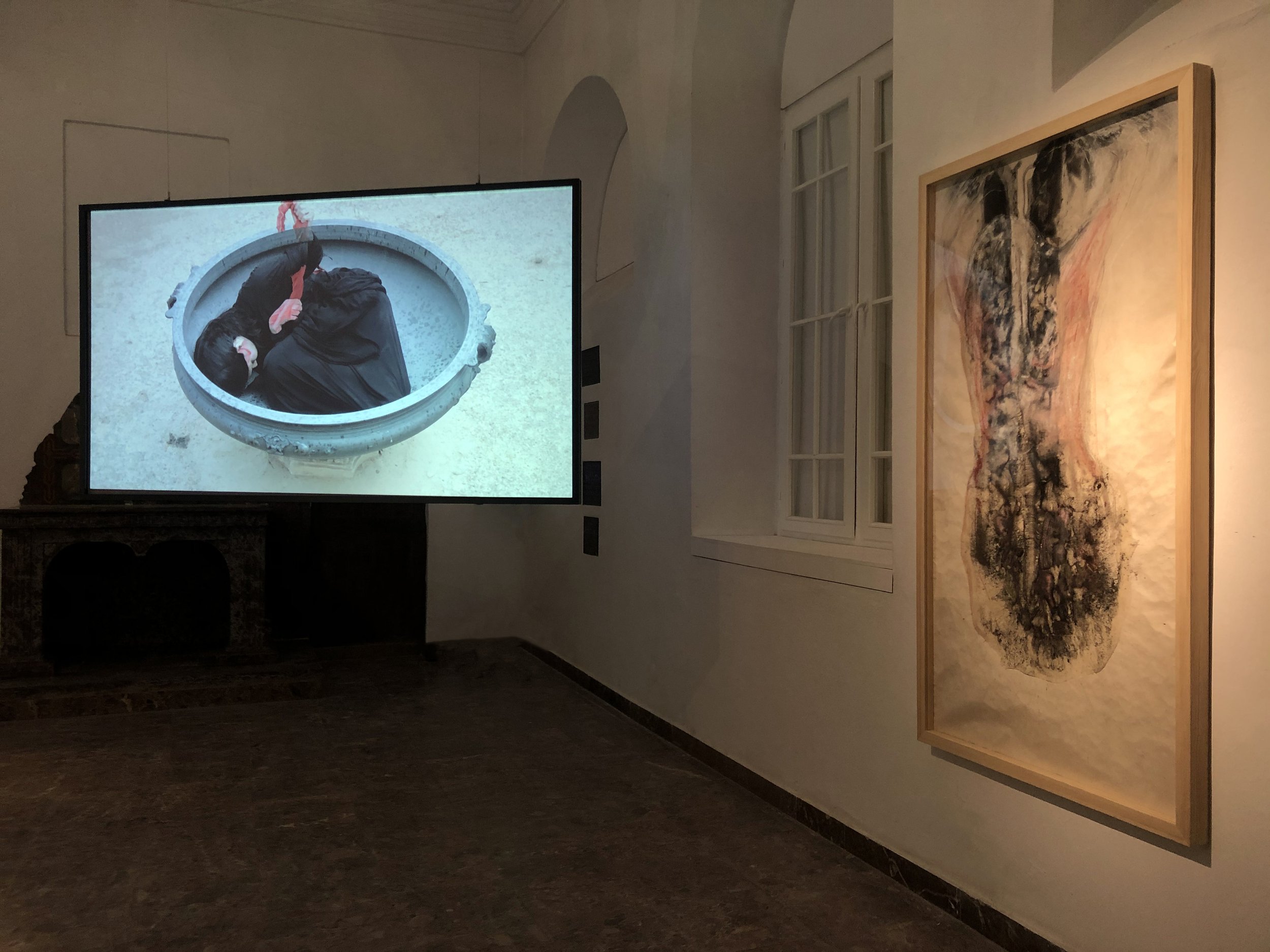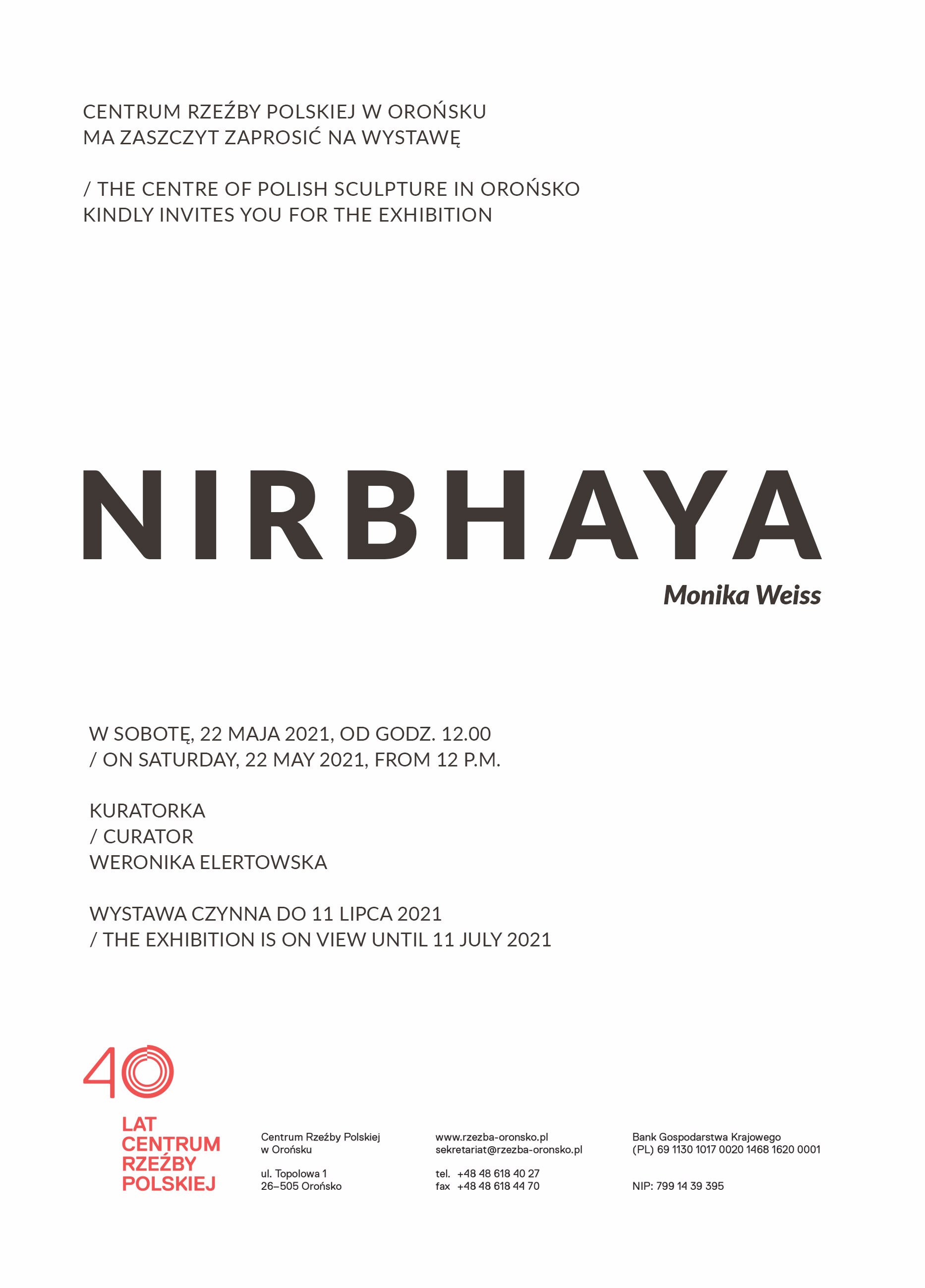dafne (for nirbhaya)
Dafne II, 2020
Dafne (for Nirbhaya)
2020
graphite powder, water, resin, pencil, dry pigment on rice paper
72 x 39 inches each
photographic documentation by Jean Vong
Artist Statement
Dafne (for Nirbhaya) is a cycle of 12 large-scale drawings on rice paper. In this cycle of drawings I symbolically depict the moment in which a living body of a woman becomes a living body of a tree. Her skin hardens into bark, her voice becomes whispering leaves. Referring to the mythological figure of Daphne, the drawings focus on the act of self-transformation and escape from the violence of rape, marked by death, but also a reincarnation into a new life form.
- Monika Weiss
Essay Excerpts
We shall stand before Dafne (for Nirbhaya), 2020, large-scale, vertically hung, graphite powder, resin, water, dry pigment — a series of abstract, material drawings that evoke both a body and the rough surface of a tree’s scaly bark. Their title refers us the mythological figure Dafne, from Ovid’s tales of metamorphosis, The river nymph Daphne was pursued by a rapacious Apollo and called out to father or mother to save her from rape by the sun god. She was transformed into the laurel tree; thus, she died but was made into a living thing (…) Nirbhaya distils and transforms the aesthetic procedures and formal languages honed by Monika Weiss across her long series of audio-visual-sonic-performance-graphic works over twenty years. In her practice, often inspired by the necessity to re-remember real events or focus on specific places of events, Monika Weiss has sought out many forgotten stories and overlooked sites of anguish in the traumatic history of the European world and beyond by focussing, not exclusively, on violation of the humanity of women. Perhaps I should rephrase that. By making the moving bodies of women, often including her own, a mobile alphabet of pathos, her art speaks against violence at levels that reach back to the most archaic origins of ritual confrontations with life and death, terror and pathos.
- Griselda Pollock, The Fidelity of Memory in an Endless Lament in Monika Weiss-Nirbhaya, Centre of Polish Sculpture in Orońsko, 2021, pp. 12 - 50 [to read the essay click here]
In Ovid’s account, the ‘heavy numbness’ (or torpor gravis) that overtakes Daphne’s limbs, the ‘sluggish roots’ (pigris radicibus) that replace her ‘quick feet’, and the submersion of her chest sub cortice - under a ‘carapace’, ‘husk’ or ‘rind’ of bark – all vividly convey a kind of retreat enforced by violence, a form of self- abnegation that can also be understood as resistance and refusal. In calling upon her father, the river-god Peneus, to help her, Daphne requests that he ‘change and destroy the [very] body that has given too much delight’, sacrificing her powers of motion and speech – in effect, her bodily agency – in order to maintain a minimal degree of autonomy. Monika Weiss’s Dafne drawings capture this act of simultaneous resistance and self-abnegation with remarkable strength and economy. We see not a literal covering of bark but a kind of co-constitution of woman and tree, as torso becomes trunk. The structural components of spine, thorax, waist or shoulder solidify in some drawings into almost sculptural fragments (evoking, for me, the Belvedere Torso, thought by some to be a depiction of Philoctetes or Ajax, both mythical figures famous for their bodily pain or mental anguish). In others one has the sense of veining, of pulsating organs, of ramifying vascular systems as they shift themselves into a different kind of life-form. Body and tree provide metaphors for each other – trunk and limb, veins and crowns, ‘heartwood’. But this is not a ‘tree of life’, ‘knowledge’ or ‘enlightenment’, as we know from other cultural traditions. This is the tree as partial, fragmented thing – in which life appears numbed, submerged, protected, and virtually concealed.
In Kiki Smith’s version of Daphne, the female body’s subjection to repeated trauma through the plucking of branches is figured in a particularly violent way (and offers us a more explicit take on Bernini). Monika Weiss gives us something very different. Dafne and Nirbhaya explicitly forgo the re-presentation of violence in their move to a more recuperative model of what she calls ‘un-forgetting’ – one that makes possible an aesthetics of care. Although Daphne-as-tree figures a form of retreat and resistance, it also gestures to a different way of being-in-the-world. As the eco-philosopher Emanuele Coccia writes, plants may “affect a sovereign indifference toward the human world, the culture of civilizations, the succession of domains and ages”, but “they are far from being shut in on themselves: no other being adheres to the world that surrounds it more than plants do … They participate in the world in the totality of everything they meet.” At the same time, plants are “domestic titans that do not need violence to found new worlds”.
- Verity Platt, How a Woman Becomes a Tree, part of the international symposium Monument/Anti-Monument inspired by Monika Weiss’ Nirbhaya, organized by CEL Centre for Architecture + Design St. Louis, 2021 [to view the panels click here]
Exhibitions
Monika Weiss - Nirbhaya, Centre of Polish Sculpture in Orońsko, Poland, May -July 2021
Publications
Monika Weiss - Nirbhaya, Centre of Polish Sculpture in Orońsko, 2021
















